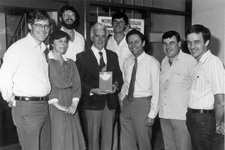CROSS CURRENT
with MARGARET RODGERS
Have you ever read a book about someone you know? It's interesting to compare the book's impressions with your own.
What may well prove to be the most significant 2006 event for Moore College, celebrating its 150th year along with three other major institutions within the Diocese, saw a large crowd gather in early July. They were there for the launch by Archbishop Sir Marcus Loane of Dr Marcia Cameron's biography of former principal Canon David Broughton Knox. Titled An Enigmatic Life: Father of Contemporary Sydney Anglicanism and published by Acorn Press, it is a handsome volume, with an arresting photo on the cover. It is Broughton unadorned, and will immediately bring to life again all the varied views people held of him.

For many of his students and diocesan lay people he was an unmatched leader and guide along the paths of biblical orthodoxy; for some others he was an obstinate, irascible teacher, given to changing his mind and leaving you unsupported just when you thought you had grasped the essence of his argument; for others, and many from outside the diocese especially, he is viewed as an eminence grise, culpable for all that is in error over recent decades within the Diocese of Sydney. For some he was friend, counsellor, brother, brother-in-law, dearly loved husband and loving, though sometimes flawed, father.
Given that mix, it is surely a daunting task to attempt a biography of such an enigmatic individual. Yet Marcia Cameron has done so, and left the Diocese of Sydney and Moore College in her debt. Since Broughton Knox was Principal from 1959 to 1985, her biography is a significant contribution to the history of the Diocese and its ministry. Marcia is a careful, painstaking historian and meticulous in her research. This is evidenced in her first chapter in particular, and in the appearance of all the well-known stories, rarely told these days, of diocesan disputes, often between the Principal of Moore College and the denizens of Church House (now named St Andrew's House). The material is enhanced by the access Marcia was allowed to Broughton Knox's own papers, so that in her chapter on his war-time experiences his voice is clearly heard, for it is based on his personal journals.
Everyone who knew Dr Knox has their favourite stories about him " here is one of mine. I always enjoyed sitting with him in the College Dining Room at lunch watching him eating his orange from a plate with a knife and fork.
Marcia Cameron notes the Christian hospitality that Broughton and his wonderful Ailsa exercised from their home. One person who often enjoyed this pleasure was their near neighbour from down the road, a lady who could be in her day as determined and strong minded as Broughton was himself, though usually from the other side of the debate. I am aware that in July 1969 there was a new television in the Principal's residence. On July 20, Mary Andrews was invited by Broughton and Ailsa to go to their house in the evening and sit with them and their children to watch Neil Armstrong take his first steps on the moon " a touching tribute to the warmth and openness of their home.
Marcia Cameron is an interesting and accessible writer. She touches on his disappointments and his sorrows. Yet she makes clear that Moore College, and therefore the Diocese of Sydney, is what it is today because of Broughton Knox " markedly his encouragement for faculty and gifted students to pursue postgraduate theological research, his recognition of the importance of a well-equipped library for students and researchers, his acquisition of neighbouring property to serve the ever-increasing College community, all of these have fed into the College as a model theological community.
I wished that more attention had been paid to the political climate surrounding the ordination of women debate in the Anglican Church of Australia. This would have supplied the reason for Dr Cameron's comment that while numbers of male students increased at Moore in the 1970s, "The number of women attending lectures fluctuated'.
The next work on Broughton Knox should be a theological reflection of his writings. Marcia Cameron has pointed the way, but at times had not enough space to pursue matters to their end. But this is a book not to be missed. It is a careful history written by someone who admires her subject yet is sufficiently distant to notice his human flaws. This is its strength. Marcia Cameron is a historian, not a hagiographer.
















